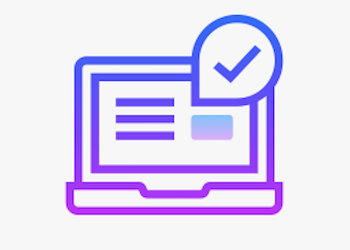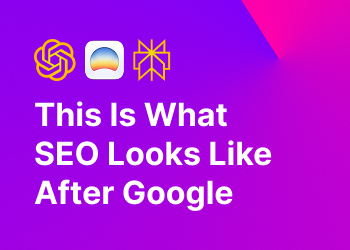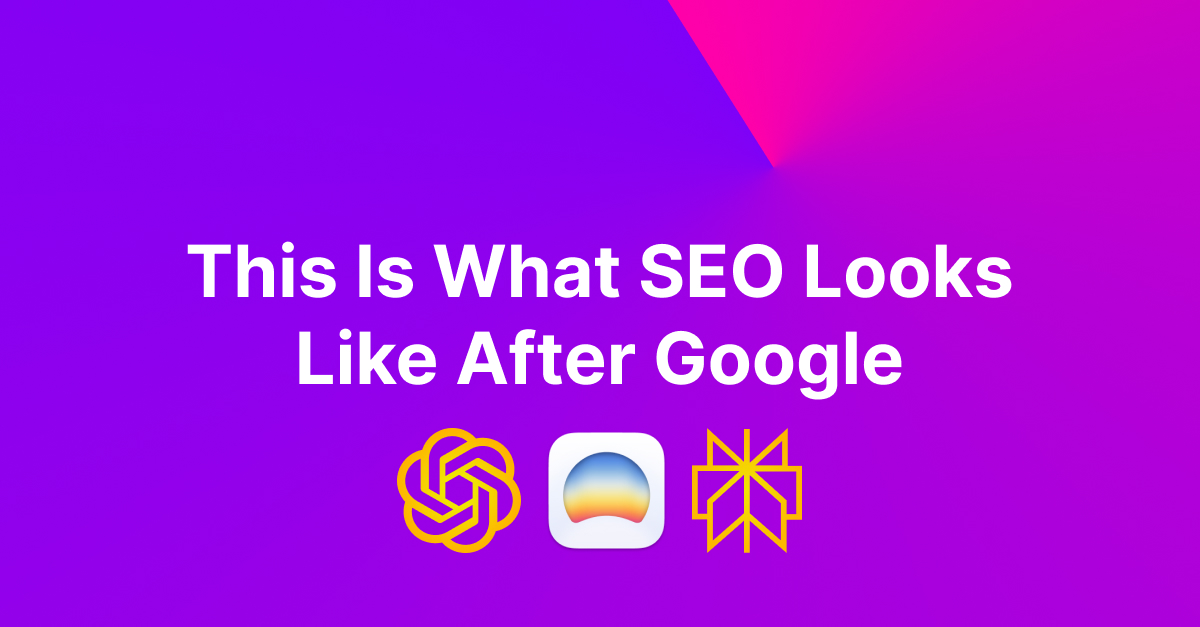One Size Does Not Fit All: A Case Study


What if your website could automatically adapt to different visitors without requiring constant attention from you? This case study will show you how easy it is with ezbot AI.
Why Do Businesses Only Have One Website?
Imagine you own a store that sells pants. If you were only able to manufacture one size, you’d be limited in who you sell to. You’d either have to make them large enough to fit most people, but the majority of people would require a belt. You could make them a size 6, but then only people who are that size would be able to buy them, alienating anyone larger. It is obvious to us that selling more sizes of pants increases the number of people who can buy them. Not only do they fit everyone better, but they also fit more people. Why is this obvious in the context of clothing, but not in the context of websites?
Think about the last time you bought a car. Did the salesperson show you the exact same vehicle as the previous customer? Of course not. They asked about your family size, driving habits, and budget, then showed you cars that matched your specific needs.
The one-size-fits-all approach doesn't work for pants, hats, car seats, or websites. Instead of trying to come up with one website that speaks weakly to everyone, we should all have a version of our website that speaks directly to each kind of user.
Yet most small businesses are stuck with a one-size-fits-all website. We know instinctively that different visitors have different preferences, but who has time to constantly analyze customers and decide what to show each kind?
Introducing: WalkingCanes.com
WalkingCanes.com discovered this firsthand when they tried ezbot. Even when they don’t have time to brainstorm new website tests, ezbot carries their conversion rate by showing different users different websites.
This case study focuses on a month in which nobody lifted a finger, but ezbot’s custom AI model helped WalkingCanes.com sell 11% more. See for yourself how ezbot turns more websites into more sales.
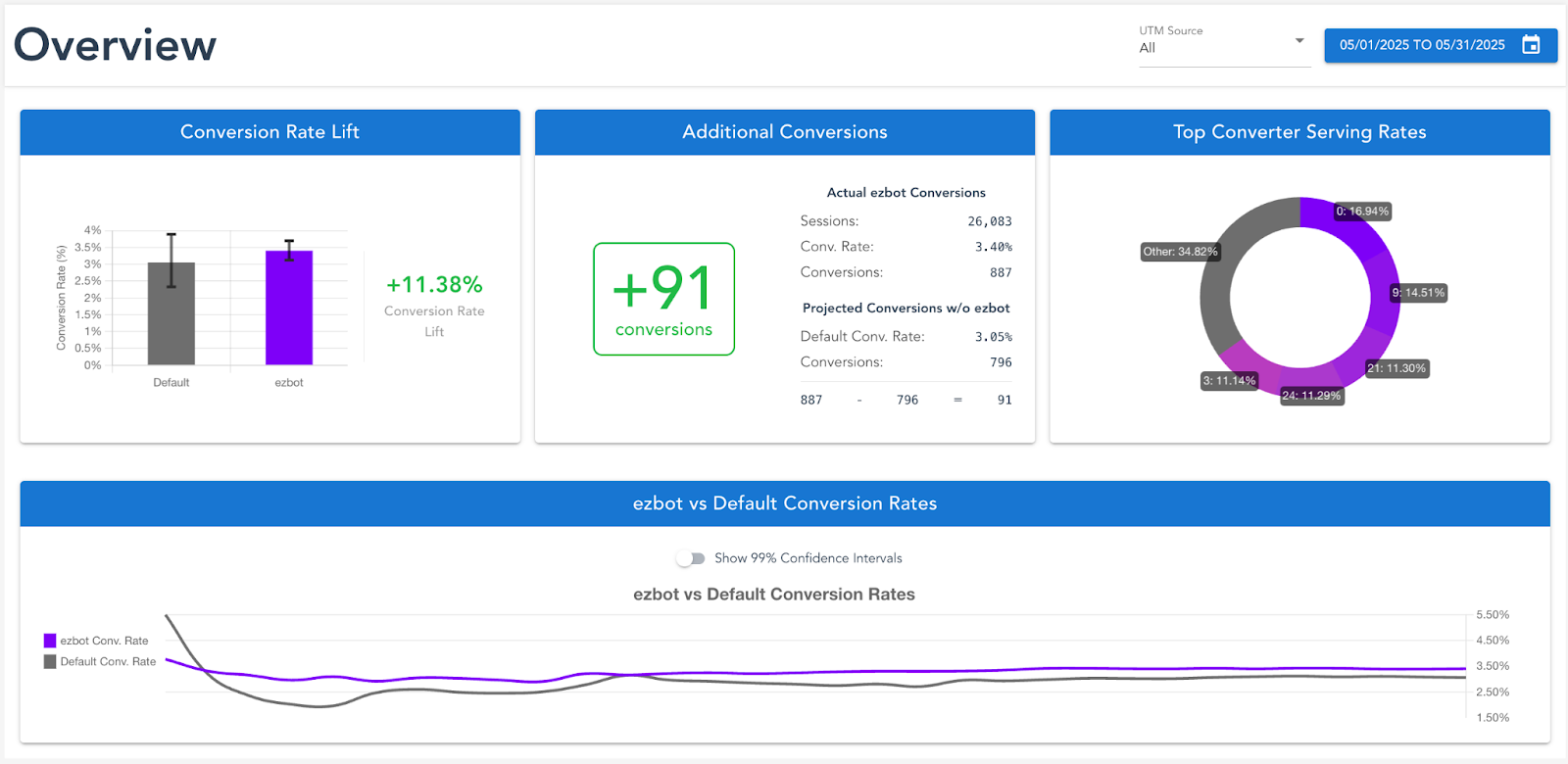
Setting Up Multiple Websites is Easy
It’s easy to get 30 different versions of your website with a tool like ezbot because you can try any idea you have. The changes you make to your website combine with each other to multiply how many websites you end up with. Simple changes like showing and hiding a pop-up will double your total number of unique websites (we call this a combination). Add in three versions of a call-to-action and five button colors and you have 2 x 3 x 5 = 30 versions of your website.
Getting Your Website to Convert More Is Easier
All of those combinations would be too much for a human to analyze manually, but our AI tracks and learns from thousands of combinations every day.
Below, you will find some of the top performing combinations WalkingCanes.com was showing in May, along with data about their conversion rates and the percentage of traffic that was shown each combination.

But here's the crucial insight: WalkingCanes.com didn't need to figure out which combinations work best for which visitors. The AI handles all of that automatically.
If you look at the 30-day Conversion Rate and the trends over the last 14, 7, and 3 days, you can see that Combo 9 has been doing worse this month, while Combos 24, 3 and 25 are all improving. Nobody has to keep track of this, notice the changing stats, and make traffic adjustments. Instead, this happens automatically as ezbot AI keeps your website’s conversion rate as high as it can be with the combinations you’ve given it.
The results? ezbot AI's optimized combinations achieved a 3.40% conversion rate compared to the default 3.05% -- an 11.38% improvement that generated 91 additional conversions in just one month. This is a big difference for a small business.
Multiple Websites Outperform One-Site-Fits-All
Consider the hotly debated pop-up: store owners want people to sign up for their newsletter, but they also want people to buy products. Does having a newsletter pop-up on your site help or hurt sales?
The answer is both. Some people are happy to share their email, feel like a part of the family, get a discount, and keep shopping. Others are annoyed at the pop-up, close it, or even leave the website. The magic of ezbot AI is that it figures out which people are more likely to convert if they see the pop-up and which people are less likely to convert – showing it to some people and not to others.
For WalkingCanes.com, rather than forcing them to choose one approach for everyone, ezbot AI automatically shows the pop-up to 61% of visitors and hides it from 39% – because the AI learned that different visitors respond differently to the same element.
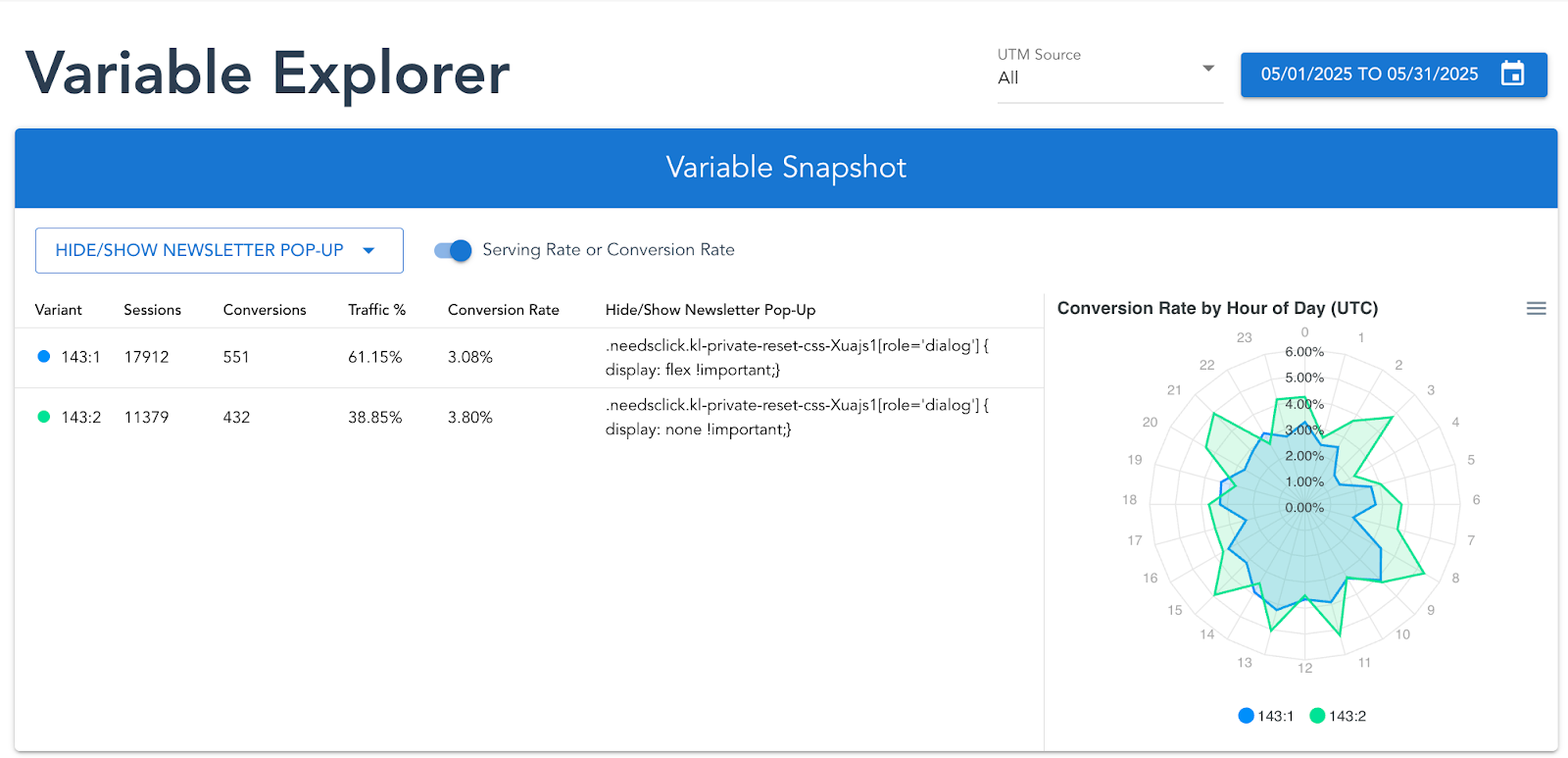
With the Variable Explorer that ezbot AI generates, one can see that showing the pop-up still converts more than default (3.08% instead of 3.05%) but hiding the pop-up converts even better at 3.8%. Both are being shown because both improve WalkingCanes.com’s conversion rate in their own contexts.
While it is fun to ask “Why?” there will always be infinite ways to explain the data. For example, it could be the case that people on mobile are not being shown the pop-up, while people on desktops are, or that returning customers aren’t shown the pop-up, but new ones are. We’re constantly building state-of-the-art analytics tools to help business owners learn about their customers.
With ezbot AI, you can be sure that each version of your website is being shown to the user it is most likely to convert. This is just one example of how ezbot AI improves the overall conversion rate of your website by improving the conversion rate of each combination, showing people what they respond best to.
Why One Website Leaves Money on the Table
The fundamental challenge with standard websites isn't that they're poorly designed, it's that no single design is preferred by everyone in your audience.
Please bear with me while I go on a short statistical tangent. Remember, we have two variations of the pop-up variable: show converts 3.08% and hide converts 3.8%. Why is it that just showing one of these to all of our traffic would lower our conversion rates below even 3.08%?
The bottom line is that breaking down data into subgroups gives us the power to be more effective and convert more users. In marketing, this is often called “segmentation” and “personalization”. In statistics, this is what causes Simpson’s Paradox, and you can find countless explanations and examples of it online. What happens is that when you combine averages of groups with different sample sizes, the overall averages may not be representative of the smaller groups.
The Complex Data Analysis Problem (Solved)
You might be thinking: "This sounds incredibly complex. How do you know which version to show to whom?"
You're right. This level of personalization used to require teams of data scientists and months of analysis. That's exactly why most businesses stuck with the one-size-fits-all approach.
But AI changes everything. Consider a hypothetical example based on WalkingCanes.com’s data.
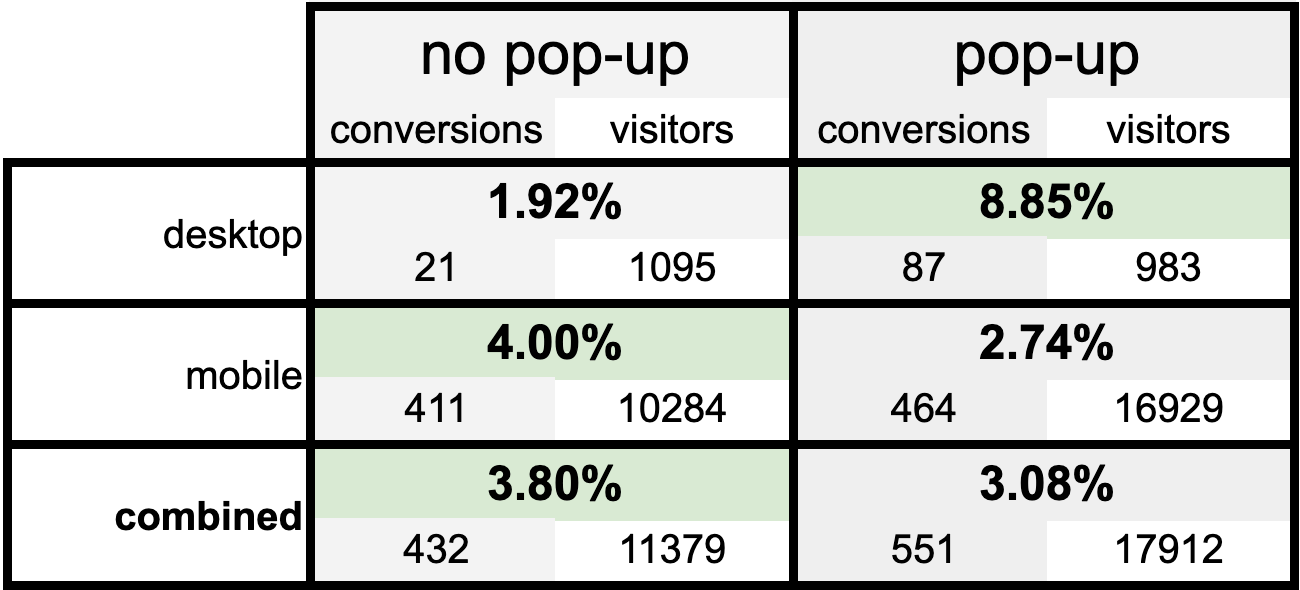
One analyst might assume they should hide the pop-up for everyone because it has a higher conversion rate overall. However, some desktop users prefer the pop-up. If you could serve all desktop users the pop-up and all mobile users no pop-up, and conversion rates were the same, then you could push conversion rates up even higher, up to 4.34% in this example.
Of course, user preferences change, outliers regress to the mean, and websites change, so the idea of a “perfect” optimization may seem a bit silly. However, ezbot AI out performs traditional website testing tools because it strives for this ideal of perfect personalization, and delivers more value than any analyst, tool, or team.
WalkingCanes.com, a small business with modest traffic and limited resources, didn't need to analyze data, make decisions, or manage multiple campaigns. ezbot AI handled it all behind the scenes.
ezbot AI's machine learning system automatically:
- Identified patterns in visitor behavior within seconds of arrival
- Predicted which website version was most likely to convert each individual
- Continuously learned and improved these predictions
- Handled all the complex statistical analysis in the background
WalkingCanes.com didn't need to hire data scientists or spend months analyzing user segments. They simply installed ezbot AI and let it figure out who should see what.
The Future Is Automated Personalization
WalkingCanes.com's success represents more than just a good month of sales. It demonstrates how busy small businesses can get sophisticated optimization results without the traditional time investment.
The era of constant manual optimization is evolving. In its place, successful businesses are embracing automated personalization that works behind the scenes – serving each visitor the experience most likely to convert them, without requiring ongoing attention from the business owner.
Your customers aren't all the same, but you shouldn't have to spend all your time managing different experiences for them. With the right AI tools, your website can automatically adapt while you focus on running your business.
WalkingCanes.com proved that this approach delivers real results. Any business can unlock hidden conversion potential in their existing website without constant optimization work.
The question isn't whether automated personalization works. The question is: how much potential revenue are you leaving on the table with a one-size-fits-all approach?
Ready to see what automatic personalization could do for your conversion rates? WalkingCanes.com generated 91 additional conversions in 30 days without any ongoing optimization work. See how ezbot AI can automatically personalize your website for different visitors.
Try ezbot AI for free for up to 30 days and see how much value it brings to your website.

